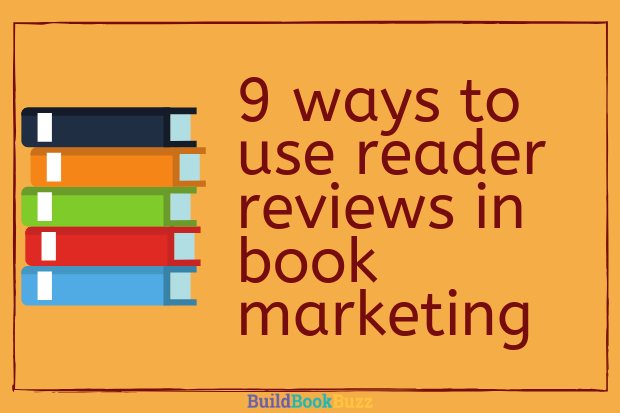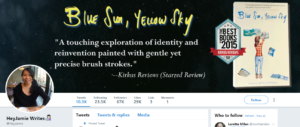9 ways to use reader reviews in book marketing
You already know that reader reviews on Amazon, Goodreads, and anywhere else books are sold online are essential.
They’re the social proof you need to convince people to buy your books.
But did you know you can make glowing reviews work harder for you?
Give your five-star reviews new life by incorporating them into your book marketing and promotion campaigns and material. Here are nine ways to use reader reviews in book marketing. You can get started using them immediately.
EDITED TO ADD: Helpful commenters below remind us that the reviewer owns the copyright on the review, so ask for permission before using it.
1. Add them to social media headers.
Use one (or two!) in your Facebook page cover image, Twitter and LinkedIn headers, and Instagram profile.
Here’s how Jamie Jo Hoang showcases a starred Kirkus review of Blue Sun, Yellow Sky in her Twitter header.
2. Showcase them on your website.
Where you place them on your site depends on your site design and purpose, but many authors can find a home for a good review next to a book cover image on the home page.
Do you have a page on your site for each of your books? Add the positive reviews there, too, in a large font.
3. Create quote cards with them.
I’m a big fan of using quote cards (also known as “image quotes“) to share good news on social media. They’re perfect for every social network you use.
I created several from the positive reviews of the new Build Book Buzz Reader Book Review Forms. Here are two of them.
Here’s one for The Wife Between Us. (Scroll down the page at that link, too, to see more of them that the publisher created.)
Create them using Canva.com or with a smartphone app that combines images and text. I like using WordSwag.
4. Print them on bookmarks.
Bookmarks are probably the most commonly used book marketing materials. They’re easy to create today, thanks to online services that include Moo.com (affiliate link).
A pithy reader review quote is one of my top five elements for a bookmark. The others are the book title, cover image, your name, and your website URL.
5. Add them to postcards.
No, printed postcards are not passé. Because more and more (and more and more) marketers have shifted away from postal mail to email marketing, printed marketing materials get noticed in a traditional mailbox.
Yours will make the best impression possible when you include a glowing reader review. You can order them online with VistaPrint (search online for a coupon code to use with your order) and Moo.com (affiliate link).
6. Add them to the back pages of subsequent books.
Each time you write a book, add reviews of earlier books to the back. This will help readers discover your “backlist” — your older books.
If you are stopping at one book, but will publish an updated edition, add those reviews to the front of the newest version. They will add the social proof you need for someone flipping through your book in a physical store or online.
7. Use them to improve your book’s description.
Did a reviewer describe your novel’s character in a positive, memorable way?
Did a reader add an observation about your credibility and expertise to a nonfiction book review?
When it makes sense, update your online description with this new information. For example, if a reader describes your twenty-something amateur sleuth protagonist as “a millennial Nancy Drew,” use it in the book’s description.
In the mid-1990s, when a journalist described me as “the Ermba Bombeck of the ’90s,” the publisher added that phrase to my first book’s back cover description.
8. Incorporate them into your next book’s marketing campaign.
Readers considering your new book are influenced by what others have said about your previous works.
Use that to your advantage by adding positive reviews on earlier books to:
- The inside pages of your newest book
- Printed marketing materials such as bookmarks and postcards
- Website
- Facebook page
Introduce those reviews with this simple sentence: “Here’s what readers have said about (AUTHOR NAME)’s previous books.”
9. Let them guide what you write in your next book.
Reader feedback can provide important insights into what your fans want from you.
For example, if readers adore one of your secondary characters, you can capitalize on that by giving her a bigger role in your next book.
Perhaps fans of your instant pot cookbook rave about your vegetarian recipes more than anything else. Give them a vegetarian instant pot cookbook, too.
Need help getting those reviews? You’ll love the Build Book Buzz Reader Book Review Forms. There’s one for fiction, another for nonfiction.
Each is a simple, easy-to-use fill-in-the-blanks form that you give to readers to help them write more reviews. Buy one form; share it with as many readers as you want. Learn more on the Reader Book Review Form information page.
How do you use your favorite reader reviews? Please tell us in a comment.
Like what you’re reading? Get it delivered to your inbox every week by subscribing to the free Build Book Buzz newsletter. You’ll also get my free “Top 5 Free Book Promotion Resources” cheat sheet immediately!






Excellent information, Sandra. Thanks.
Sometimes the best comments come not from reviews but from my blog.
That’s really interesting, Kathy. Is there a way you can use them?
Thanks for stopping by and commenting.
Sandy
I use them the same way I use review excerpts.
Thanks!
Sandy
Do you get written permission from the reviewers to use their comments in multiple ways for marketing? Or is it just assumed in the trade that once the comment is out there, you can use it however you want?
That’s a great question, S. It’s my understanding that you don’t need to get permission. The whole point of reviews is to influence readers one way or the other — to read or not read the book — so the more they are shared, the more readers they will help. I’ve looked into Amazon’s review terms, guidelines, rules, etc. and haven’t found anything about this, but I haven’t talked to an attorney.
Sandy
I read somewhere that it’s acceptable to share review and comment excerpts of twenty-five words or less.
… without permission.
Thanks, Kathy! And that concept of excerpting them is key for another reason. Typically, the entire review is too long to use anyway. What you want (and I know you know this) is just the most compelling part — a “Best book I’ve read this year!” sort of thing.
Thank you!
Sandy
Thanks for the informations in this article.
I had the same problem some months ago. I just took some reviews I knew the reviewer and asked them for permission.
But it’s good to know, that I can use an excerpt of the review anyway.
Best regards
Stephan
Thanks, Stephan. You were smart to ask for permission. Also, sometimes, an excerpt is more compelling than the full review.
Sandy
I use them – with permission. But you have great ways of doing that.
The author of a review OWNS the copyright. Because they created the intellectual property. They probably won’t argue with you about it, but there is no such thing as ’25 words or less’ – copyright law is often decided AFTER someone does something that offends the creator. The NOLO copyright handbook is a good place to start.
It’s easier to contact the authors, thank them for the reviews, and ask. Then keep the emails you get back.
Everyone I’ve ever contacted has told me I can use their review with no restrictions – after all, I’m asking those who loved the book.
But don’t assume – and there are no easy ways to just grab something you didn’t write.
As an author, I want to be particularly sensitive about other writers’ rights (yes, reviewers are writers).
Such excellent advice, Alicia. Thank you. And you can ask a reader’s permission in an Amazon review by replying to their review.
Sandy
Hadn’t been aware I could do that.
I usually follow the advice of leaving the reviews and comments for readers, but if people are informed when they leave a review, it would be nice for those who don’t make their email address available. And when in doubt, I tend to go with the more conservative option or the one least likely to be contentious.
Thank you!
Oh, number 7 is clever and I’ve not seen it mentioned much. Definitely should be more common. Great catch!
Thanks, Adrijus! Glad it made you think.
Sandy
Not just me hehe! Shared it around and people are loving it:
https://www.quora.com/q/the-writers-nook/9-ways-to-use-reader-reviews-in-book-marketing-Build-Book-Buzz
Keep up the good work!